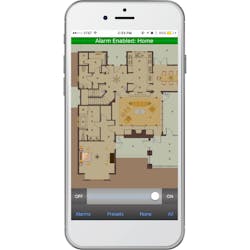Earlier this week, Jim Clark, the entrepreneur and founder of a number of highly successful businesses including WebMD and Shutterfly, made his foray into the security industry with the launch of CommandScape, a building management system designed specifically for high-end residential and commercial properties.
Company officials emphasize that CommandScape is not just another smart home or do-it-yourself security gizmo but rather an integrated control solution that can combine disparate systems into a single, easy to use and cyber-secure platform.
“A building management system traditionally (consists of) the big heating, ventilation and air conditioning systems and we’re really redefining that entire category to really not only include all of that but also security, lighting, video surveillance, fire and smoke detection, access control, and then wrapping that all together with a full network monitoring environment,” says Don Boerema, the company’s president and CEO.
Boerema, who formerly served as senior vice president and chief corporate development officer for ADT, says that CommandScape enables all of these different systems to be fully integrated with one another and easily controlled by the user on their mobile device with the CommandScape Navigator app. The app features a customized floor plan of the customer’s property or properties overlaid onto a user interface that gives them the ability to interact with the various integrated systems from anywhere in the world. The CommandScape Editor feature also enables a homeowner or property manager to customize schedules, presets, automations and alerts based on their personal preferences. In addition, CommandScape is also easy for integrators to install and maintain as they can remotely troubleshoot client systems.
“Many (building management) systems today – when you look at the commercial world or large homes – are all point solutions. They are all individual solutions that you have to manage with one set of passwords and a separate system: one manages my lighting, one manages my access, one manages my security, one manages my HVAC or VMS, and all of those are embedded systems that do not do any kind of interoperability,” Boerema explains. “In fact, the majority of them don’t do anything when it comes to really leveraging all of these security sensors – motion, door/window sensors, etc. – but they could be used to trigger (different systems). Take a simple thing like motion detectors which could be used as a trigger for your lighting or air conditioning, which if there is no one in the room or a lot people in the room you could adjust things accordingly… but there aren’t really any systems out there that provide that full interoperability.”
Given the focus around cybersecurity and ensuring that connected systems are not compromised by hackers, CommandScape has placed a premium on making sure the platform is secure by leveraging the Transport Layer Security (TLS) protocol. The forerunner to TLS, Secure Socket Layer (SSL) was actually developed by Netscape, which was also founded by Clark.
“This entire environment is wrapped in a cybersecurity envelope,” Boerema says. “Really no one has ever used two-way authentication like we’re doing where it is validating the client and server basically and I think that’s a big difference for us. Having this rock solid environment and we’ve done lots of testing and everything else and Jim Clark created this 20 years ago at Netscape so he knows it pretty intimately, it is bullet-proof as far as getting into the environment we have now. Outside of that environment, if somebody has a computer that’s on that network and they get a phishing email and download a malicious attachment, that’s not within kind of our four walls of our certificated process but anything within our walls – lighting, security, access control, video, etc. – are all fully secured by having a certificate on every device.”
Boerema says the reason they decided to at least initially focus on high-end residential and commercial properties was that they realized there was a need for improved interoperability of systems in this market and that there wasn’t anything else available that really fit the needs of these particular users.
“There is huge need for interoperability across all of these different capabilities and there is not a solution in the marketplace that will integrate all of these in a cyber-secure envelope or, to be honest with you, integrate them period. I’m in a building right now that has three motion detectors next to each other that are driving different activity – one is for security, one is for lighting and one is for temperature. They are not even leveraging the same environment,” he adds. “There aren’t solutions out there that integrate all of those things. They will integrate said pieces of that, some will take your home theater and integrate it with lighting and shades but no one is doing it across all of these different areas and they’re not doing it in a secure manner.”
Boerema says the company is currently looking to partner with several different systems integration firms to bring the platform to market. “Integrators are putting in these VMS and HVAC systems and integrators are putting in these large lighting and security systems, so we are talking to all of those partners about representing our platform as we go forward,” he says.
For more information about CommandScape, visit www.commandscape.com.
About the Author:
Joel Griffin is the Editor-in-Chief of SecurityInfoWatch.com and a veteran security journalist. You can reach him at [email protected].


